What is "the Conclave" and what happens at one?

The institution of the Conclave is the mechanism by which a new pope is elected. While not strictly necessary by nature, theologically or canonically, it has been confirmed by the 1996 document as still appropriate. In February 2013, the norms were amended slightly by Benedict XVI’s final Motu Proprio Normas nonnullas.
The word itself comes from the Latin cum clave (literally “with a key”) and meant that the cardinals were locked in the Apostolic Palace until they produced a result.
Under the 1996 regulations, the cardinals are to be housed in a building inside the Vatican’s walls called the Domus Sanctae Marthae (St Martha’s House) and move from there to the Papal Palace and the Sistine Chapel for the actual voting process.
While they are moving to and from their new accommodation, they are forbidden to communicate with anyone not involved in the election.
During the vacancy of the Apostolic See, the Cardinals are to wear the usual black cassock with piping and the red sash, with skull-cap, pectoral cross and ring.
Others admitted to St Martha’s House for the duration of the Conclave and sworn to secrecy include:
At a suitable point, two ecclesiastics known for their sound doctrine, wisdom and moral authority have the task of presenting to the cardinals two well-prepared meditations on the problems facing the Church at the time and on the need for careful discernment in choosing the new Pope.